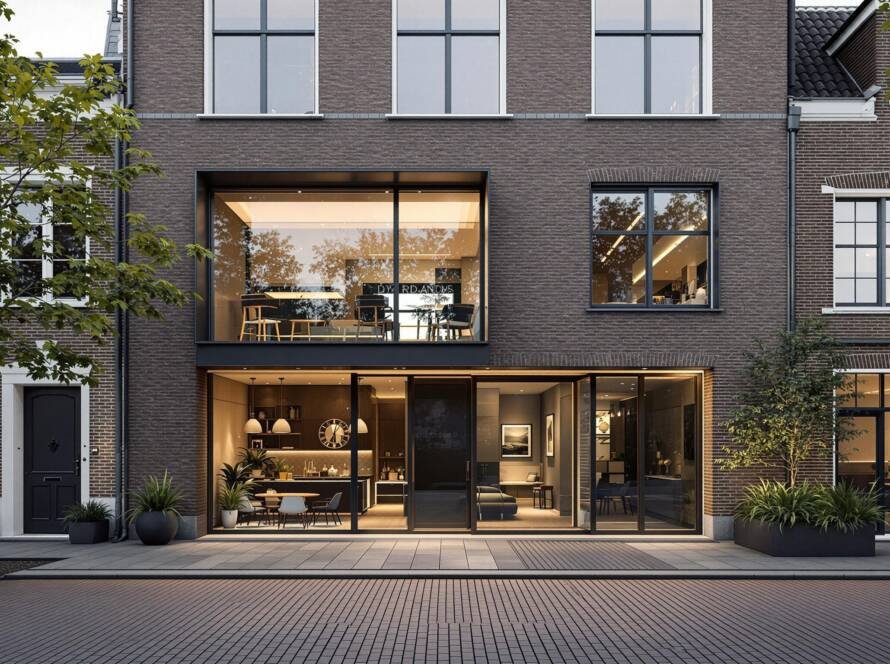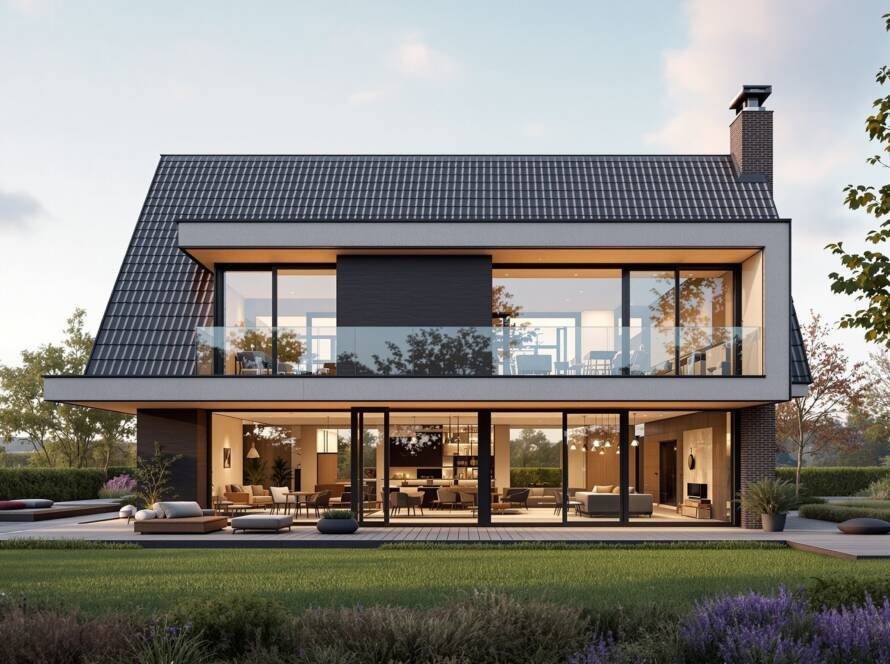The Dutch home is a unique blend of historical charm and modern innovation. From the iconic canal houses of Amsterdam to the sleek, energy-efficient new builds (nieuwbouw) rising across the country, there is a constant drive to enhance comfort, sustainability, and style. In this pursuit of the perfect living space, a new player has emerged, poised to redefine how we interact with our environment: the smart window. This is no longer the stuff of science fiction; intelligent window solutions Netherlands are becoming a cornerstone of contemporary house renovations and extensions. This article delves deep into the world of high-tech windows, exploring the technology, the profound benefits for Dutch homeowners, and the practical steps for integrating these systems into your next project.
Basic Concepts: What Exactly Are Smart Windows?
At its core, a smart window, also known as switchable glass or dynamic glass, is a type of glazing whose light transmission properties are altered when voltage, light, or heat is applied. In essence, it is a window that can change from transparent to translucent or tinted on command, or even automatically. This technology goes far beyond simple double or triple glazing (HR++ or HR+++ glas). It actively manages the sun’s energy, controlling glare, privacy, and the amount of heat that enters or leaves a room.
The magic lies in a thin film or coating applied to or placed between panes of glass. This layer contains microscopic particles or special chemical compositions that react to an electrical or environmental trigger. This adaptability makes automated window systems Netherlands a powerful tool for creating a responsive, comfortable, and highly efficient home environment, perfectly suited to the variable Dutch climate.
The Technologies Behind High-Tech Windows NL
The term “smart window” is an umbrella for several distinct technologies. Understanding the differences is crucial when planning a house renovation, as each offers unique advantages. Your choice will depend on your primary goals, whether they be energy savings, instant privacy, or seamless automation.
Electrochromic (EC) Windows
Electrochromic technology is one of the most popular choices for residential applications. It works by applying a low-voltage electrical charge to a multi-layered coating on the glass. When the charge is applied, ions move between the layers, causing the glass to tint. Reversing the voltage returns the glass to its clear state. This process is gradual, often taking several minutes to transition from fully clear to fully tinted.
- Control and Functionality: Users have precise control over the level of tint, allowing for a range from clear to dark blue or grey. This can be managed via a wall switch, a remote control, or, most impressively, through a smart home system. You can program the windows to tint during the sunniest parts of the day or integrate them with weather apps and indoor temperature sensors for fully automated control.
- Best for Energy Savings: EC windows excel at managing solar heat gain. On a hot summer day in the Netherlands, you can tint the windows to block the sun’s infrared radiation, significantly reducing the need for air conditioning. In the winter, you can leave them clear to maximize passive solar heating, lowering your gas bill. This dynamic control makes them an excellent component for achieving the strict Dutch BENG (Bijna EnergieNeutrale Gebouwen) energy performance standards.
Suspended Particle Device (SPD) Windows
SPD technology offers a different kind of performance, focusing on speed and opacity. An SPD film contains countless microscopic, rod-like particles suspended in a liquid. Without any electrical charge, these particles are randomly oriented, blocking light and making the glass dark and opaque. When a voltage is applied, the particles instantly align, allowing light to pass through and making the glass transparent.
- Instantaneous Change: The key benefit of SPD is its speed. The transition from dark to clear is virtually instantaneous, happening in less than a second. This makes it ideal for applications where rapid changes are desired, such as in a home cinema or a bathroom.
- Privacy and Glare Control: Because SPD can go fully opaque, it offers complete privacy on demand. It’s also excellent for completely blocking out harsh glare. However, a key consideration is that it requires a constant (though low) electrical current to remain in its transparent state. When the power is off, it defaults to its dark, private mode.
Polymer Dispersed Liquid Crystal (PDLC) Windows
Often seen in corporate boardrooms and modern offices, PDLC technology is now making its way into Dutch homes. It operates using liquid crystals dispersed within a polymer matrix, sandwiched between two layers of glass or film. In its default, unpowered state, the liquid crystals are randomly arranged, scattering light and making the glass appear milky white and translucent. Applying an electrical charge aligns the crystals, making the glass instantly transparent.
- The Privacy Specialist: PDLC is the go-to solution when the primary requirement is privacy. It’s perfect for street-facing windows in a rijtjeshuis, for partitioning a room, or for bathroom windows. It allows diffused light to pass through even when in its private mode, so the room doesn’t become completely dark.
- Limitations: While excellent for privacy, PDLC is not a strong performer in managing solar heat gain or glare. Its primary function is to switch between clear and private, not to dynamically tint and control energy flow like electrochromic windows.
A Comparative Overview of Smart Window Technologies
To help you visualize the differences, here is a table comparing the main types of smart glass available for your Netherlands home renovation.
| Technology | How It Works | Primary Benefit | Control | Switching Speed | Energy State |
|---|---|---|---|---|---|
| Electrochromic (EC) | Low voltage charge moves ions to tint the glass. | Energy efficiency, solar heat control, glare reduction. | Variable tint levels, fully automated potential. | Slow (minutes). | Requires power to change state, then holds state with minimal power. |
| Suspended Particle Device (SPD) | Voltage aligns suspended particles to allow light through. | Instantaneous privacy and darkening. | On/Off control, can be fine-tuned. | Instant (<1 second). | Requires constant power to stay transparent; defaults to dark. |
| Polymer Dispersed Liquid Crystal (PDLC) | Voltage aligns liquid crystals to switch from translucent to transparent. | Instant “on-demand” privacy while still allowing light. | Simple On/Off control. | Instant (<1 second). | Requires constant power to stay transparent; defaults to private. |
Practical Tips: Planning Your Smart Window Integration
Successfully incorporating smart windows Netherlands into your home requires careful thought and professional execution. These are not standard building materials, and their implementation must be planned meticulously. Do not attempt a DIY installation; the wiring, integration, and handling of these high-tech materials demand specialized expertise.
Assess Your Primary Need
Before you proceed, define your main goal.
- Is your primary concern the high summer sun on your south-facing glass extension (uitbouw)? Then electrochromic windows are likely your best bet for managing heat.
- Do you live on a busy street and crave instant privacy without closing curtains and losing all light? Consider PDLC technology.
- Are you building a dedicated media room and need the ability to go from bright to blackout in a second? SPD windows are the superior choice.
Your specific use-case will guide your technology selection and ensure your investment delivers the maximum benefit.
Factor in the Dutch Building Code (Bouwbesluit)
Any major renovation or new build must comply with the Dutch Building Code (Bouwbesluit), which includes strict requirements for energy performance (BENG). Discuss with your architect and renovation specialist how the chosen intelligent window solutions Netherlands will contribute to your home’s overall energy efficiency rating. The superior insulation and solar control offered by smart windows can be a significant factor in meeting or exceeding these standards, potentially improving your home’s energy label (energielabel) and long-term value.
Plan for Electrical and System Integration
This is a critical step that must happen early in the design phase. Ensure that your plan includes provisions for the necessary low-voltage wiring to each window unit. These wires must be run discreetly within the walls and window frames before any finishing work is done.
Furthermore, decide on the level of Dutch home technology integration you desire.
- Basic Control: Will you be satisfied with simple wall switches for each window?
- Centralized Control: Do you want a central panel or remote to control all windows at once?
- Full Automation: Do you envision the windows being part of a larger smart home ecosystem (like Google Home, Apple HomeKit, or a dedicated system like KNX)? This allows for creating scenes like “Movie Night” (which dims lights and tints windows) or “Good Morning” (which slowly clears the bedroom windows).
Discuss these options with your renovation team to ensure the correct infrastructure is put in place.
Budget as a Long-Term Investment
There is no hiding that the initial cost of smart windows is significantly higher than that of traditional high-performance glazing. However, it is crucial to view this not as a simple expense but as a long-term investment. The benefits accumulate over time through:
- Lower Energy Bills: Reduced reliance on heating in winter and cooling in summer translates to direct savings year after year.
- Increased Property Value: A home equipped with cutting-edge, functional technology is highly attractive on the Dutch property market. It represents a forward-thinking investment in comfort and sustainability.
- Enhanced Lifestyle: The added comfort, convenience, and aesthetic appeal have an intangible value that improves your daily life in the home.
Ensure you receive a clear quotation that separates the cost of the window units from the installation and integration labour.
Conclusion: The Future is Clear, and Sometimes Tinted
Smart windows represent a significant leap forward in residential design and technology. For homeowners in the Netherlands undertaking a house renovation or building an extension, they offer a powerful solution to the unique challenges of the Dutch climate and the demands of modern urban living. From achieving superior energy efficiency compliant with BENG standards to providing unparalleled privacy and comfort, high-tech windows NL are transforming our relationship with our homes.
The successful implementation of these systems is not a simple upgrade but a core part of the architectural and electrical design. By understanding the different technologies, carefully planning for integration, and working with skilled renovation professionals, you can unlock the full potential of these remarkable windows. As you plan your next project, consider how these intelligent and dynamic surfaces can bring your Dutch home into the future, creating a living space that is not just smart, but brilliant.




